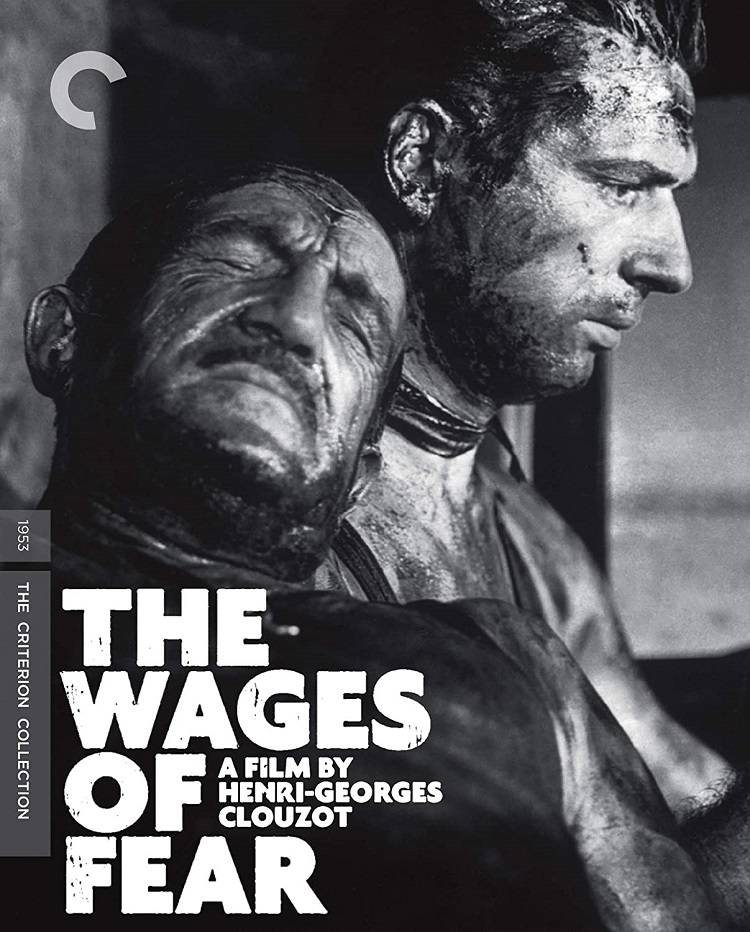
Winner of the Palm D’Or at Cannes, Henri-Georges Clouzot’s The Wages of Fear is based on the novel by Georges Arnaud about a group of European expatriates stranded in the desolate South American town of Las Piedras. The potential to get out presents itself to four men when an American oil company offers $2,000 each to complete the extremely dangerous mission of transporting nitroglycerine across dirt roads to a location where an oil well is burning out of control. Out of this simple premise, Clouzot creates a suspenseful, intriguing thriller from a situation that has no outside protagonist.
The film opens with a group of cockroaches scurrying around as they are tied together, a plaything for a half-naked child in the street, which makes a great visual metaphor for the characters we are about to meet. (Similar imagery was used years later in Peckinpah’s The Wild Bunch.) There are a few Europeans in Las Piedras, but they have no money to leave and no prospects for jobs so most just lounge around outside the local tavern harassing the owner to pass the boredom.
A fire breaks out at a Southern Oil Company oil rig on the other side of the mountain, and the only way to extinguish it is with nitroglycerine; however, getting the volatile material is so dangerous the company can’t get the union workers to do it, so they offer the job to any local townsfolk who can drive a truck. Although the company has been accused of exploiting local workers, some of whom have died in accidents, many people turn out for the opportunity. The men selected for the task are Corsican Mario (Yves Montand), who is having an affair with the tavern’s waitress, Linda (Véra Clouzot); Italian Luigi (Folco Lulli), whose work with cement has given him terminal lung disease; German Bimba (Peter Van Eyck), who was forced to work salt mines during the war; and Russian Smerloff (Dario Moreno).
The main character not picked is the Parisian Jo (Charles Vanel), a gangster who recently bribed his way into town and pushes everyone around. When he gets the Oil Company manager, a former compatriot, to make him a backup, no one is surprised when Smerloff doesn’t show up by the departure time.
The trucks leave a half hour apart for safety, but they constantly meet up and cross paths as the journey affects each driver and his driving differently. Jo’s nerves get the best of him and he starts off with Mario at so slow and steady a pace Luigi and Bimba catch up and pass him. The first obstacle is a patch of road so rough it resembles a washboard. It is determined the best way to handle it is by driving 40 mph to minimize the shaking of the truck. However, Luigi doesn’t keep the truck moving that fast which appears to be a problem as Mario swiftly approaches behind. I got so caught up in the moment I yelled out at the drivers. Even though they are European, their nonchalance and frequent smoking near the nitroglycerine puzzled me.
On their journey, the men have to deal with backing the trucks up on a platform made of rotten wood in order to complete 80-degree turn, a large boulder blocking the road, and a large pool of oil due to a broken pipe. In addition to the editing by Henri Rust and Madeleine Gug, what keeps the tension ratcheted so high are the very real consequences that result in injury and death. And just when you think it’s over, the story offers one final twist to create food for thought to take with you as the credits roll.
The Blu-ray edition of The Wages of Fear is presented in black and white with an aspect ratio of 1.33:1. The packaging states it is a “restored high-definition digital transfer,” and although I can’t compare it to previous releases, the video offers mixed results. The photography has good contrasts and sharp details for the most part. The liner notes state that “thousands of instances of dirt, debris and scratches were removed,” but in some shots, scratches can be seen running top to bottom through the frame. There also appears to be feint damage to the negative and occasionally the white from images and bright lights bleed through. Another problem is the high definition causes the fake, filmed backgrounds to be more obvious.
The audio is presented in Mono 1.0. It sounds good but reveals its age and brings to mind the sound quality of watching foreign film in rundown theatres. The language is mostly French with English subtitles.
The Special Edition Features contain three Video Interviews. From 2005, assistant director Michel Romanoff talks about how he joined the crew and shooting the film, and biographer Marc Godin, co-author of Clouzot: Cinéaste, talks about the director’s life and his character. From 1988, Montand talks about acting in a segment for the French television program Cinéma Cinémas. Also for French television is Henri-Georges Clouzot: The Enlightened Tyrant, a 2004 documentary about the director’s career.
An intriguing feature is “Censored,” which examines the cuts made by distributors for the film’s 1955 U.S. release, which removed scenes with perceived anti-Americanism and homosexual undertones. This caused the film to be 15 minutes shorter and it was not until 1991 that a restored version was screened in the country. Author Dennis Lehane touches on this area in his essay in the liner notes.
For those who enjoy substance of characters and theme with their action, Henri-Georges Clouzot’s The Wages of Fear is a great choice.